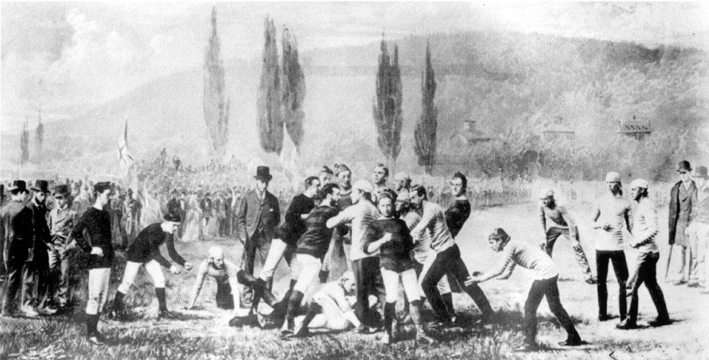Every sport has a rubicon to cross, a dividing line between infancy and legitimacy. A concoction of traditions, house rules, and conventions huddle together and break apart across time, forming and reforming to become an entity that doesn’t look anything like its predecessors, but has elements of all of them. For football, that moment came on a crisp November day in New Haven, Connecticut, 140 years before Super Bowl 50.
Though it is now the most widely-followed American sport, football was invented in Canada. First known as “mob football” where peasants would try to transport a ball from one location to another by any means necessary short of murder. The teams’ sizes were elastic, there were no designated playing fields to speak of, nor any written rules for that matter. Settlement in the United States gradually brought the game from the streets of England to America’s elite universities where schools like Princeton, Yale, and Harvard would play semi-organized matches that resembled modern soccer more than anything. Generally, two teams of 25 players on a field would try to kick a ball (they couldn’t touch the ball, but they were encouraged to physically attack their opponents any way they could) into the other team’s goal. These games became so violent that football was banned at the collegiate level for a few years.
Meanwhile, the game became popular at McGill University in the form of rugby, different from American football in that the ball was oblong instead of round, and players could carry it instead of just kick it. Players could also score ‘tries’ by moving the ball past the other team’s end of the field, a way of scoring that evolved into what we now know as a touchdown. The American and Canadian worlds eventually collided in a May, 1875 two-game series between McGill and Harvard, where one game was played with Harvard’s rules and the other one with McGill’s.
Harvard liked McGill’s rules so much that they advocated for their use in the November, 1875 game against Yale. Yale countered with its own set of rules and—in perhaps the most important compromise in sports history—the universities sat down and negotiated for a combination of the two playing styles (though mostly favouring McGill’s rugby style), creating football’s first set of codified rules. In their game—now played annually and known simply as “The Game” for its importance—Harvard’s experience led them to a 4-0 shutout. In attendance that day was a dissatisfied Yale student named Walter Camp, better known now as the “father of modern football.”
A member of the Skull and Bones Society and triple-varsity athlete, Camp was responsible for smoothing the rough edges that the Harvard-Yale compromise had created in the gameplay. He attended university conventions where football’s rules were debated and expanded—this included regulations such as introducing the line of scrimmage and the system of downs to keep the game moving quickly, cutting down team sizes to 11 on each side, and changed the scoring so touchdowns yielded more points than field goals. Camp had shaped what was an awkward combination of soccer and rugby into something workable. In the years after his changes were made, college football exploded in popularity, radiating outward from the Eastern seaboard.
Enter Glenn Scobey “Pop” Warner, essentially football’s first beta tester. A coach known for doing anything to win, Warner exploited the same loophole that would one day let golden retrievers play professional basketball: There was no rule specifically forbidding it, so it was allowed. Warner used every diversionary trick in the book, sewing football-shaped patches onto players’ jerseys to confuse the opposition and adding pockets to the insides of jerseys so his players could run the ball with no danger of getting it knocked away. Warner, along with other prominent coaches of the time were integral to the evolution of the game; if somebody is trying to exploit the game in any way they can, then the rules are going to change to prevent them from doing that, and thus the game becomes more legitimate.
Nearly half a century after Camp walked out of the Yale-Harvard match, the NFL was formed, further shaping the game into what its known as today. It’s impossible for Camp to have seen the future coming from his vantage point, but he must have been cognizant of the violent, unorganized mayhem of the game’s origin stretching back farther than he could comprehend. The compromise showed him that there was a way forward from all that–a way that wasn’t necessarily perfect or safe, but forward for the sport of football.







